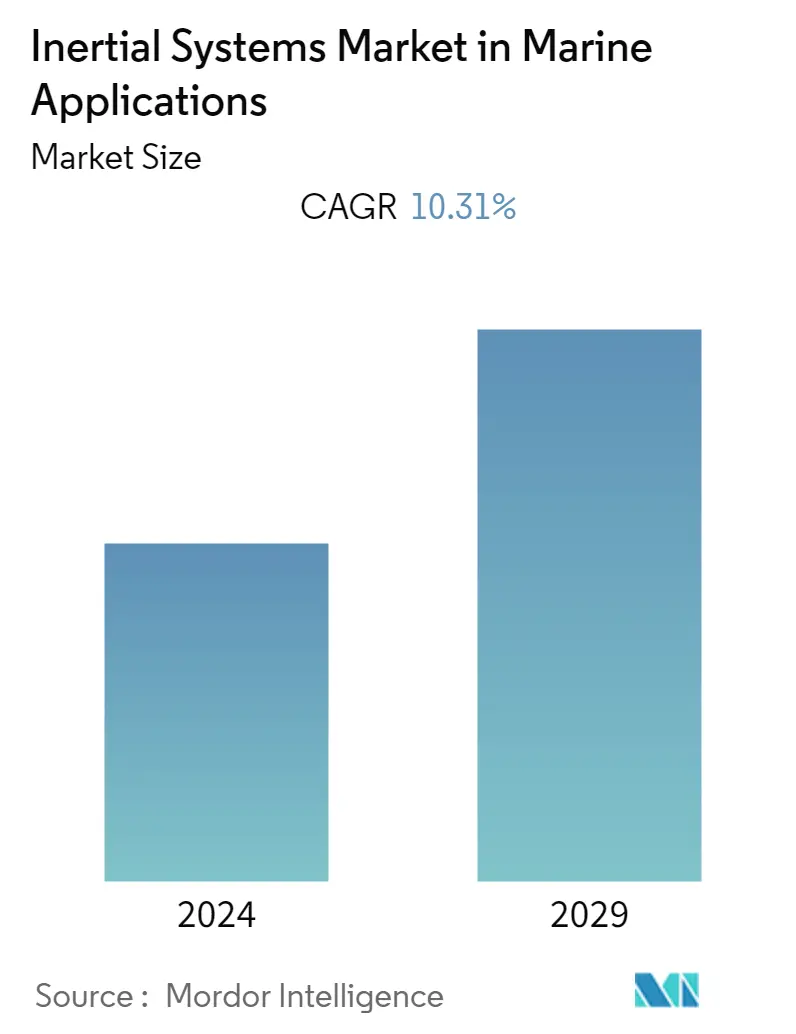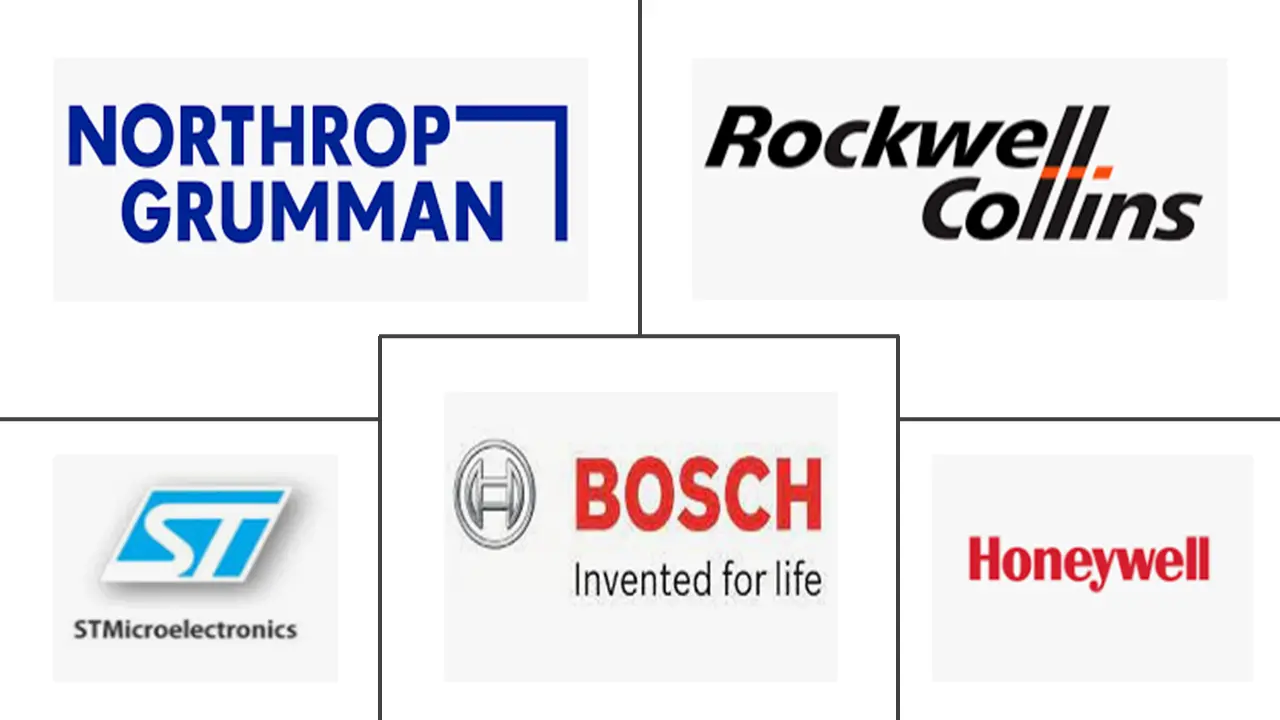Market Size of Inertial Systems Industry in Marine Applications

| Study Period | 2019 - 2029 |
| Base Year For Estimation | 2023 |
| CAGR | 10.31 % |
| Fastest Growing Market | Asia-Pacific |
| Largest Market | North America |
| Market Concentration | Medium |
Major Players
*Disclaimer: Major Players sorted in no particular order |
Marine Applications Inertial Systems Market Analysis
The inertial system market in marine applications is expected to record a CAGR of 10.31% over the forecast period. The rapid advancement of the global lifestyle has produced easier equipment to operate, accomplished with the use of motion-sensing technology that heavily utilizes inertial sensors.
- MEMS-based solutions have gained popularity in the navigation sector over the past few years due to improved error characteristics, environmental stability, increased bandwidth, improved g-sensitivity, and the growing accessibility of embedded computing power to run sophisticated fusion and sensor error modeling algorithms. Vendors are switching from FOG to MEMS technology, and antenna array stabilization applications appear to follow suit.
- The cost differential between MEMS-based systems and conventional FOG or RLG navigation systems, which cost over USD 30,000 instead of USD 1,000 for MEMS-based navigation systems, is one of the main factors driving growth in MEMS-based systems. However, compared to other systems on the market, FOG- and RLG-based solutions provide more precision.
- The market is also being driven by an increase in applications based on motion sensing. The ongoing downsizing of sensors and related components is concentrating progress toward sophisticated function sensors. For instance, Xsens improved versions of its motion-sensing Inertial Measurement Unit (IMU) modules from the MTi 1-series, which offer improved roll, pitch, and yaw measurement accuracy and higher tolerance of mechanical stress compared to the first generation of the product in various energy and infrastructure projects.
- The price of INS systems, including purchase, operation, and maintenance, is a drawback. Other drawbacks include heat dissipation and escalating navigational mistakes over time. The size, weight, and power criteria are still greater than those for GPS receivers, although they decrease over time as technology advances.
- Numerous commercial and non-commercial operations have been put on hold due to the COVID-19 outbreak. The shipping and maritime sector is one of the businesses severely impacted by the outbreak. Since their workforces have been curtailed for safety reasons and to stop the spread of COVID-19, the pandemic has left the shipping and maritime sectors in the worst conceivable position.
Marine Applications Inertial Systems Industry Segmentation
The inertial navigation system (INS) is a self-contained navigation mechanism that tracks the location and orientation of an item in relation to a specified starting point, orientation, and velocity using data provided by accelerometers and gyroscopes.
The inertial systems market in marine applications is segmented by component (accelerometers, IMUs, gyroscopes, magnetometer, attitude heading, and reference systems) and geography.
The market sizes and forecasts are provided in terms of value (USD million) for all the above segments.
| By Component | |
| Accelerometers | |
| IMUs | |
| Gyroscopes | |
| Magnetometer | |
| Attitude Heading | |
| Reference Systems |
| By Geography | |
| North America | |
| Europe | |
| Asia-Pacific | |
| Rest of the World |
Inertial Systems Market in Marine Applications Size Summary
The inertial systems market in marine applications is experiencing significant growth, driven by advancements in motion-sensing technology and the increasing adoption of MEMS-based solutions. These systems are crucial for providing orientation, position, and velocity data to various unmanned marine and maritime systems, such as autonomous underwater vehicles and remotely operated vehicles. The shift from traditional FOG and RLG technologies to MEMS is largely due to the cost-effectiveness and enhanced performance characteristics of MEMS systems, despite the latter offering less precision. The market is also influenced by the ongoing miniaturization of sensors and components, which is enabling the development of more sophisticated and functionally advanced sensors. However, challenges such as the high cost of INS systems, heat dissipation, and navigational inaccuracies over time continue to pose obstacles to market growth.
The Asia-Pacific region, particularly China and India, is a key driver of market expansion due to its rapidly growing economies and dominant position in global trade and transportation. The region's increased demand for navigational accuracy and the development of high-performance accelerometers are contributing to the market's growth. The market is partially fragmented, with numerous solution providers focusing on product development, strategic partnerships, and acquisitions to enhance their market presence. Notable players in the industry include Honeywell International Inc., Bosch Sensortec GmbH, and Northrop Grumman Corporation. Recent developments, such as the acquisition of iXblue by Groupe Gorgé and the launch of new IMU products by Silicon Sensing Systems and SBG Systems, highlight the ongoing innovation and strategic maneuvers within the market.
Inertial Systems Market in Marine Applications Market Size - Table of Contents
-
1. MARKET INSIGHTS
-
1.1 Market Overview
-
1.2 Value Chain/Supply Chain Analysis
-
1.3 Industry Attractiveness - Porter's Five Forces Analysis
-
1.3.1 Threat of New Entrants
-
1.3.2 Bargaining Power of Buyers
-
1.3.3 Bargaining Power of Suppliers
-
1.3.4 Threat of Substitute Products
-
1.3.5 Intensity of Competitive Rivalry
-
-
1.4 Assessment of COVID-19 Impact on the Industry
-
-
2. MARKET SEGMENTATION
-
2.1 By Component
-
2.1.1 Accelerometers
-
2.1.2 IMUs
-
2.1.3 Gyroscopes
-
2.1.4 Magnetometer
-
2.1.5 Attitude Heading
-
2.1.6 Reference Systems
-
-
2.2 By Geography
-
2.2.1 North America
-
2.2.2 Europe
-
2.2.3 Asia-Pacific
-
2.2.4 Rest of the World
-
-
Inertial Systems Market in Marine Applications Market Size FAQs
What is the current Inertial Systems Market in Marine Applications Industry size?
The Inertial Systems Market in Marine Applications Industry is projected to register a CAGR of 10.31% during the forecast period (2024-2029)
Who are the key players in Inertial Systems Market in Marine Applications Industry?
Honeywell International Inc., Northrop Grumman Corporation, Rockwell Collins, Bosch Sensortec GmbH and ST Microelectronics are the major companies operating in the Inertial Systems Market in Marine Applications Industry.

